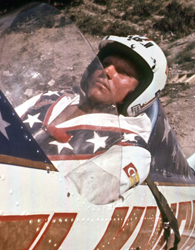Evel Knievel was one of the world’s most famous daredevils. In honor of his birthday, we explore his rise to fame, his bone-breaking stunts and his darker, more violent side.
Evel Knievel’s Early Days
Born October 17, 1938, in Butte, Montana, Evel Knievel began his life as Robert Craig Knievel. At the age of eight, Knievel was fascinated by a traveling auto daredevil show. Only five years later, he stole his first motorcycle, a Harley Davidson.
Knievel dropped out of high school in the tenth grade. He was frequently in trouble; the teen was charged with theft of hubcaps, and reckless driving. The police gave Knievel his famous nickname, “Evel,” while he was in county jail.
After a short stint in the army, which Knievel claimed straightened him out, the daredevil returned to his hometown, where he married Linda Bork, a woman he had previously been charged with kidnapping. The pair began to build their family while Knievel explored a series of careers: hockey player for the Charlotte Clippers; team manager for a semiprofessional local hockey team and owner of a hunting expedition company which brought tourists to shoot elk at Yellowstone National Park.
Sources in this Story
- Evel Knievel.com: Evel Knievel: The Man
- The New York Times: Evel Knievel, 69, Daredevil on a Motorcycle, Dies
- YouTube: Evel Knievel and the Caesar’s Palace
- Doug Malewicki: The X-1 Skycycle
- The Economist: Evel Knievel
- ESPN: Evel Knievel and Wide World of Sports: A winning combination
- SI Vault: Returning Good For Evel
- USA Today (AP): FBI file details Knievel’s dark side
Knievel’s Notable Accomplishments
At the age of 27, Knievel, who was then part owner of a Moses Lake, Washington, motorcycle shop, came up with a way to get more business. He announced he would jump his motorcycle 40 feet over parked cars and a box of rattlesnakes before riding past a mountain lion. Technically, the stunt was unsuccessful: he landed in the box of snakes. But the 1,000-strong audience he drew inspired him to turn his hobby into a career.
Knievel traveled the United States as leader of a motorcycle stunt troop for several years. In 1967, he gained near-instant fame when he tried to jump the fountains at Caesar’s Palace in Las Vegas. He made the 151-foot jump, but missed the landing, horrifying the 15,000 onlookers with the sight of his body lying twisted and crumpled on the pavement.
After a month-long coma and the repair of a broken skull, ribs, pelvis and hips, Knievel was back on the bike, successfully jumping 52 cars at the Los Angeles Coliseum. Although he had planned to jump the Grand Canyon, Knievel was prevented from doing so by the Department of the Interior and had to jump over Idaho’s Snake River Canyon instead. Riding a specially designed rocket-powered motorcycle, Knievel made it part way over the canyon before the cycle malfunctioned, ending the stunt; Knievel then parachuted to the floor of the canyon.
Because of these widely publicized flops, Knievel became better known for crashing than for jumping. The daredevil broke a Guinness world record for number of bones broken, but always kept coming back. He also crashed while jumping over double-decker buses in London and over a shark tank in Chicago. This did not decrease the American public’s enthusiasm for his antics, and action figures made in his image made more than $350 million for toymakers.
From 1973 until 1976 Knievel made frequent appearances on ABC’s Wide World of Sports. Of the seven jumps he attempted for the show, he successfully completed five.
Although he landed hundreds of successful jumps, Knievel said his greatest pride in life came from the achievements of his son, Robbie Knievel, who, after spending years in his father’s shadow, has now completed many of the jumps his father could not, including the Caesar’s Palace stunt.
The Man and his Work
The Rest of the Story
From very early on, Knievel’s reputation as an American hero was marred by rumors and incidents of violence. In 1977, Knievel was sentenced to six years in jail after he broke both arms of his press agent by beating him with an aluminum bat. Allegedly, Knievel was unhappy with how he was portrayed in a book written by the agent about his failed Snake River Canyon Jump.
The agent had written that Knievel was a frequent abuser of drugs and alcohol, which the daredevil admitted to later in life. During that time, the FBI began an investigation into Knievel, and concluded that he and his associates were involved with at least two other violent attacks.
Other troubles with the law followed Knievel throughout his life: In 1986, he was fined for soliciting an undercover agent in Missouri for immoral purposes and, in 1995, he was charged with battering a young woman he was living with. Those charges were dropped and the young woman, Krystal Kennedy, later became his second wife.
Knievel died November 30, 2007 in his home in Clearwater, Florida at the age of 69.
This article was originally written by Jennifer Ferris; it was updated October 17, 2017.











